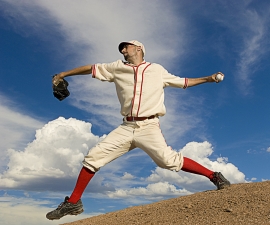
Though common, these types of injury can be a major career setback for professional athletes.
Hamstring injuries are common in athletes, especially baseball players. Whereas some sports injuries in baseball are often viewed as afflicting certain positions – the pitcher, for example, hamstring injuries don’t discriminate. They can affect the pitcher and position players. Injuries to the hamstring can range from mild to severe, but recovering from them can be a significant setback for a professional athlete, and in some extreme cases, career-ending.
Though we refer to it as a singular entity, the hamstring is a group of three muscles. They run along the back of the thigh, from the hip to the knee. These muscles allow us the flexibility we need in our legs to bend at the knee. The hamstring works in conjunction with the quadriceps muscle on the front of the leg. The quadriceps muscle is responsible for straightening the knee on the extension of the leg. Hamstring pulls, tears and strains can often occur when the force of the quadriceps muscle in the front of the leg overpowers the hamstring in the back of the leg. Picture an explosive run a player engages in after hitting the ball and then sprinting to first base, and you’ll see quadriceps firing on all cylinders and hamstrings trying to reign them in. If those hamstrings are weak or fatigued, this can be a recipe for disaster.
To date, little is known about the incidence of hamstring injuries in baseball players, especially those playing in summer leagues who are preparing for an upcoming collegiate baseball season or for being drafted by a major league team. So my colleagues and I set out to research the topic via a cross-sectional observational study that was recently published in the International Journal of Sports Physical Therapy.
What we found through our research is that baseball players who are participating in summer league getting ready for their college season or preparing for the majors tend to have a higher rate of hamstring injuries than most. Many are reporting with a history of back thigh pain or a previous hamstring injury. When that occurred, there was a higher rate of the injury occurring again.
Hamstring injuries can keep a player from advancing, postpone their careers and, in severe cases, even end them. Other studies have shown that hamstring injuries are responsible for an alarming rate of injuries and disabilities in baseball players. The question is, why?
Many injuries in sports come from not warming up properly and particularly with summer players, inexperience. There is also significant data to suggest that the recurrence of hamstring injuries is higher when old hamstring injuries were not allowed to heal completely before returning to play. Additionally, baseball is more sedentary than other sports. Players are not moving and running around all the time and have many hours where they are standing still, sitting or squatting. Then, at some point during the game, they will likely be required to engage in fast-twitch, reactionary movements or an all-out sprint – on cold muscles.
When combining these factors with the actual method of the game, it is understandable how players get injured. When there is a sudden need for the player to read and react or sprint and their body isn’t accustomed to or ready for it, injuries can and will happen.
Because the nature of baseball practice often involves throwing, batting, and catching, the muscles in the hips and legs can be neglected and become tight. The best prevention for hamstring injuries in baseball players is to train and warm-up. Deep stretches daily will help keep those muscles limber and flexible. As running and sprinting is not only a significant part of baseball and a major cause for these injuries, running mechanics drills must incorporate into the daily warm-up and training schedule, as well. Using weight-training to strengthen the hamstring and quadriceps muscles will also help keep injury incidence down.
Hamstring injuries in baseball players can be career-changers and are far too prevalent not to be taken seriously. Entire careers can be at stake as well as ongoing physical health. It can take months, if not longer, for an individual to recover from a severe hamstring injury. That can mean back to the minors, back to basic training, and a significant delay, if not an abrupt end to their career. Even in the majors, players lose too much playtime due to hamstring injuries. For every baseball career that is on the line, a change to training and conditioning is worth the effort.
Sources:
https://www.ncbi.nlm.nih.gov/pubmed/31803521
https://www.webmd.com/fitness-exercise/features/hamstring-injuries#1
https://www.ncbi.nlm.nih.gov/pubmed/31431899
https://www.ncbi.nlm.nih.gov/pubmed/24727933
https://www.ncbi.nlm.nih.gov/pubmed/26991568